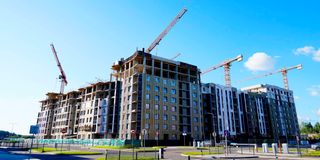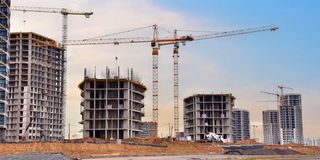Premium
Rural to urban migration driving demand for property in Kajiado’s remote towns

Within the last three years, the real estate developer notes that remote towns in Kajiado have witnessed drastic transformation.
What you need to know:
- Within the last three years, the real estate developer notes that remote towns in Kajiado have witnessed drastic transformation.
- A benefit of investing in remote places when you compare it to investing in Nairobi is the lower cost of acquiring land.
Years ago, when Dr Chrispus Wachira decided to purchase more than 40 acres of land in a remote part of Kajiado’s Kiserian town for investment purposes, many people thought he was delusional.
The real estate developer wanted to put up a 259-unit housing project consisting of bungalows and maisonettes on land that was 17 kilometres away from Kiserian town and 48 kilometres away from Nairobi.
To his critics, not only was the land quite far from the major commercial hubs, but it was also under-developed and isolated, composed almost entirely of only one ethnic community.
“Many people would question the safety of the place, even though the resident Maasais are actually the original owners of Nairobi itself,” says Wachira, the CEO of Almond Estate Company, in an interview with DN2 Property.

Dr Chrispus Wachira invested in 40 acres of land located 17 kilometers away from Kiserian town
Having successfully sold out a project in another remote part of Kajiado known as Kimuka, which was equally as far from the major commercial hubs, he did not share any of their doubts.
He believed that in a few years to come, this place was going to witness a lot of buyer interest. Part of his belief stemmed from the infrastructural developments that were going on in Kajiado, including the upgrading of key roads such as the Isinya-Kiserian road, popularly known as Pipeline Road.
This road would connect the interior parts of Kiserian to Isinya on one side and to Ngong, all the way to Suswa on the other side, meaning that people who wanted to access the northern part of Kajiado from the Southern and vice versa, wouldn’t have to go through Nairobi.
“During the late President Mwai Kibaki presidency, not only did we witness the construction of major roads, but we also witnessed other infrastructural developments including power connectivity to these areas,” remarks Wachira.
This he says, opened up the Jua Kali sector, creating a need for housing for the vast number of people who would come from the Technical and Vocational Education and Training colleges (TVETs), to work in this sector.
“The economy of Kenya is driven largely by the SME sector, once we had power connectivity, we had small businesses like salons and shops opening up, blue collar jobs mushrooming and artisans becoming of importance,” he explains.
Consequently, this would lead to a migration of people from the more densely populated parts of Nairobi, where economic opportunities were becoming scarcer, to an emerging economic centre.
“At a distance of 48km from CBD to site, we had individuals who would say the place was very far, but the simple question I would ask them is ‘far from where?’” he poses.
The critics aside, there were many people who wanted to get away from the hustle and bustle of the city and therefore saw this as a place they could relocate to and potentially even retire in.
“Once places like Kileleshwa and Kilimani moved from the low-level houses to the high rises, people started to move from these areas to places even past Isinya, from Kitengela all the way to Namanga.”
Within the last three years, the real estate developer notes that remote towns in Kajiado have witnessed drastic transformation, with the indigenous communities agreeing to sell land to developers, investors and to individuals looking to put up homes far from Nairobi.
“That aspect of people wanting to move out from the very densely populated areas of Nairobi like Eastlands, Huruma, Githurai, Kahawa, among others, has really caused the real estate sector to experience a tremendous growth,” he notes, observing that areas which were very dormant and sleepy are all of a sudden becoming very vibrant with business activities mushrooming and parcels of grazing land turning into places of habitation.

The affordable housing agenda, which was initiated by the previous government, is also likely to drive property growth.
“Birika, which is slightly ahead of our project by 3km, is now an upcoming urban centre with an assistant county commissioner, a school of aviation, warehouses, and government schools that have received an upgrade because of the people moving there,” notes the developer.
This growth, he foresees, is likely to continue, with institutions of higher learning producing and ingesting new professionals into the market that are looking for affordable places to rent.
“Affordable rent for new job entrants is nowhere else other than the suburbs of Nairobi. The suburbs like Thika, Limuru and Kiambu are mostly preferred by higher income earners. That gives towns in Kajiado a certain advantage,” he argues.
The affordable housing agenda, which was initiated by the previous government and has been adopted by the current one to meet the country’s annual demand of 250, 000 units, is also likely to drive this growth.
“Where is the land to build the number of houses that are required in this republic? It cannot be found within the cities of Nairobi, Nakuru, Mombasa or Kisumu, it can only be found in their suburbs,” states Wachira.
According to the real estate developer, since these areas remain largely untapped, land is very affordable, making it possible for individuals as well as investors to build affordably and profitably. On about half of their 42-acre piece of land in Kiserian, Wachira’s firm intends to build stand-alone affordable housing units in partnership with the national government.
The 259-unit project comprises two-bedroom bungalows going for Sh5.8 million, three-bedroom standalone maisonettes going for Sh6.8 million and four-bedroom maisonettes going for Sh7.8 million.
A benefit of investing in remote places when you compare it to investing in Nairobi is the lower cost of acquiring land and the higher potential for appreciation.
According to the latest housing survey by the Kenya National Bureau of Statistics (KNBS), between 2023 and 2024, the residential property market in Kenya showed strong demand, with more than 75 per cent of properties selling successfully in the period under review.
Vivian Kibet, a real estate investor and resident of Kajiado, says that over the past five years, rising demand has resulted in a tremendous appreciation in the value of real estate assets in these areas, compared to Nairobi where values have plateaued.
“With increasing demand for housing and commercial developments, property values in Kajiado are appreciating steadily, offering lucrative returns on investment,” observes Vivian.
As a result of devolution, she says that these areas have become independent economic hubs, with residents in these towns no longer seeing the need to go to the city to access essential amenities.
“As more people look for a lifestyle that combines urban convenience with a tranquil environment, these towns are transforming into thriving urban centers equipped with diverse amenities, making them increasingly attractive for both living and working,” says Vivian.
The cherry on top of the cake for individuals looking to buy or build holiday and retirement homes in these parts of Kajiado, is the favourable climate and scenic landscapes that offer a peaceful alternative to the bustling life of the city.
Vivian however says that a number of factors continue to dampen investment prospects in the county, including the poor state of access roads that connect the highways to the interior. Traffic snarl-ups in towns like Ongata Rongai, Kitengela and Ngong, where there is a high population density, also inconvenience commuters who reside in the more interior parts of Kajiado, particularly during the peak hours.
“While there have been improvements on the road network, infrastructure in many parts of Kajiado County remains underdeveloped, leading to accessibility issues, especially during the rainy season,” she adds.

A benefit of investing in remote places when you compare it to investing in Nairobi is the lower cost of acquiring land.
According to the Kajiado Municipality Integrated Development Plan 2023-2027, at 17 per cent, poor road network is the second most critical infrastructural challenge facing the county.
Another challenge is inadequate water supply (22 per cent), poor waste management is also a major issue (15 per cent), followed by poor drainage (13 percent) and congested markets (11 per cent).
Kevin Mungai, Land Business Manager at SIC Investment Co-operative, says that these challenges have discouraged investors from putting up high-end developments such as gated communities and commercial complexes.
“Access to reliable water supply is a significant hurdle in towns like Kitengela and Kiserian, with investors often having to rely on expensive alternatives such as boreholes and water deliveries,” says Mungai.
Although Kajiado is generally peaceful, Mungai also points out that certain areas in the county have been witnessing an increase in cases of insecurity, including petty theft and burglaries.
“Investors are often concerned about the security of their properties, leading to additional costs in installing security measures such as perimeter walls, CCTV systems, and hiring private security firms,” Mungai points out.
Ownership disputes, inconsistent land titling and fraud at land registries have also emerged as challenges that investors encounter in these areas, with cases of irregular transactions being reported in the news often.
“These kinds of disputes often delay project implementation timelines and increase due diligence costs as investors must verify land authenticity and secure clean titles before proceeding with the acquisition,” says Mungai.
Poor enforcement of zoning regulations has further diminished the attractiveness of these towns, with investors seeking structured developments having to grapple with congestion, pollution, uncontrolled development and inefficiencies in service delivery.
Regulatory approval processes in these areas are also still very complicated, seen from the multiple layers of oversight, which often require interaction from both county and national regulatory authorities.
“We have been telling the county governments that we as real estate developers are the people who are opening up these areas and they should support us by fast tracking the process of development approvals,” adds Wachira, who runs Almond Estate Company.
The real estate developer is also urging the devolved units to consider offering reduced property rates or temporary tax reliefs to developers, as well as entities that invest in critical infrastructure or public services.
“Despite the ongoing collection of property rates, water supply, road maintenance, and waste management remain an issue in these regions. This uncertainty of service delivery and high costs has caused many landowners to hesitate in developing their land,” Wachira points out.
The rising cost of construction materials, partly as a result of inflation and logistical challenges, has also affected investment, as it has increased the overall cost of property development in these areas, which are often quite interior. By offering incentives, county governments can encourage developers to build more houses, particularly under the affordable options, which can address housing shortages and improve the quality of life within these regions.
“Developers are turning areas that looked like grazing land into places of habitation, creating demand for social amenities like health centres, and bringing in more taxpayers, therefore they also need to be supported through incentives,” Wachira argues.
These incentives could take the form of subsidies on the cost of construction materials, to make homes more affordable, particularly for Kenyans who are at the bottom of the pyramid.
“The majority of our population is at the bottom of the pyramid, where the purchasing power is low. Additional costs further limit their chances of owning a home or piece of land,” Wachira concludes.





